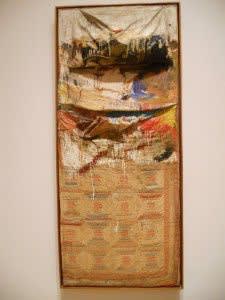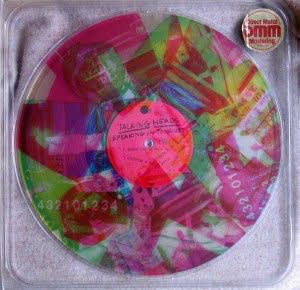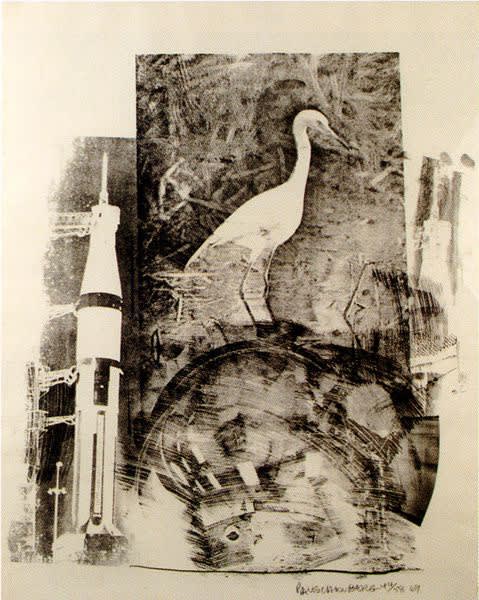Every Contemporary Art master contributes irrevocably toward the establishment or growth of one of more art movements. In the case of Robert Rauschenberg, an artist who we feature consistently in our South Florida art gallery, his untempered use of mixed media and highly contextual philosophies breathed life into the Neo-Dada and Pop Art movements that placed New York City as a Mecca of Contemporary Art during the mid-century.
Today, artists who gain favor for their use of "up-cycled" reclaimed materials, whether knowingly or not, stand on the shoulders of Robert Rauschenberg, Marcel Duchamp and a number of artists who went green years before environmentalists took notice. In the case of Robert Rauschenberg, the discarded objects he found in the trash and elsewhere on the streets of New York became prized components within his highly acclaimed works known as Combines.
Painting relates to both art and life. I try to act in that gap between the two."
- Robert Rauschenberg
For Rauschenberg, the perceptual shift of such materials - from useless discard to high art - was precisely the tools he required to build strength in the perception of his works. Rauschenberg cherished the "surprise" that could be found in such objects, as he himself was often unsure what an object would represent when juxtaposed to another. Such surprise is the magic that Rauschenberg sought to deliver.
Robert Rauschenberg's Bed (1955) is one of the artist's earliest Combines and one of his most famous. While the dripped paint likens the work to that of Jackson Pollock, it's Rauschenberg's use of color, most notably the color red, that give the piece an ominous message, easily interpreted as a sign of a violent sexual act. The ample size and dimension of this work lends itself to a certain degree of intimacy, with the viewer often feeling uneasiness to be in such close proximity to objects that typically reside behind closed doors. Robert Rauschenberg is famously quoted to have said, "Painting relates to both art and life. I try to act in that gap between the two."
Prior to creating Combines, Robert Rauschenberg first shocked the art world with his 1951 White Paintings, consisting of seven wood panels painted in white. To fully appreciate the work, one must share the artist's perspective, that the piece is in fact affected by ambient elements. For instance, the viewer or multiple viewers in fact affect the viewing experience by nature of altering light blockage variances occurring at any given time. In essence, to be present with the work is to be a contributor. Art critics found preposterous such assertions that the viewer's consumption of the work is affected by abstract components, such as sound and dust particles in the room and even the motion of trees outside. Rauschenberg created other notable monochromatic pieces, including Red Paintings and Black Paintings using mixed media painted in the same color, providing texture and variety to the works dependent upon angles of view.
Fortunately for Rauschenberg, controversy served to fuel the artist's influence, just as it did for a number of Pop Artists, including Jasper Johns and Andy Warhol. While Robert Rauschenberg's mixed media Combines initially drew attention, it was his juxtaposed combinations of popular American cultural images that inked the artist into art history as a leader of the Pop Art movement.
Perhaps the most famous of Rauschenberg's Pop Art contributions is the Stoned Moon series of lithographs. The genesis for this series was Robert Rauschenberg's participation as a viewer of 1969 launch of the Apollo 11 rocket, having been officially invited by NASA. Years prior, Rauschenberg had been responsible for the creation a non-profit organization called Experiments in Art and Technology (E.A.T.), which brought together the communities of fine artists and technical engineers. NASA reworded Rauschenberg with access to archives and assorted photos that made their way into the artist's highly acclaimed Stoned Moon works.
Throughout his career, Robert Rauschenberg collaborated frequently with musical artists, dance and performance artists, often lending his talents to the creation of elaborate sets and costumes. The artist's worldwide acclaim landed him remarkable opportunities for collaboration.
Rauschenberg was commissioned by auto maker BMW to contribute to the BMW Art Car Project, which included his painting of BMW 635 CSI in 1986. Also in the 1980's, the artist's talents landed him a Grammy Award for the album cover he designed for the Talking Head's Speaking in Tongues album.
Artist Robert Rauschenberg discusses Erased de Kooning Drawing, 1953, one of his most controversial works. It is now in the permanent collection of the San Francisco Museum of Modern Art.
Visitors to VFA Gallery in Boca Raton, FL are welcome to view the latest works of Robert Rauschenberg now available for sale. As always, we offer our assistance to anyone seeking a specific Rauschenberg for their collection. If you have questions about any of the Pop Art, Abstract Expressionist Art or Optical Art works that we procure, please feel free to stop by, give us a call or contact us online.


![Robert Rauschenberg, White Painting [seven panel], 1951. Oil on canvas, 72 x 125 x 1 1/2 inches. Collection of the artist.](https://artlogic-res.cloudinary.com/w_740,c_limit,f_auto,fl_lossy,q_auto/ws-artlogicwebsite1062/usr/library/images/main/news/82/rauschenberg-white-paintings-300x197.jpg)


